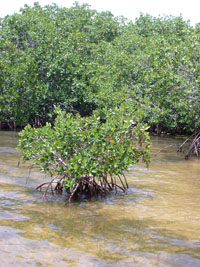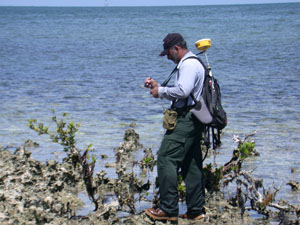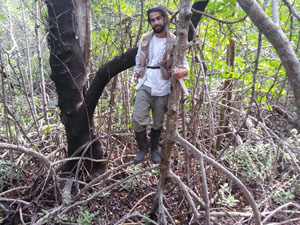 Coastal wetlands in South Florida come in many forms, including mangroves, coastal prairies, salt marshesand tidal freshwater marshes. In subtropical and tropical regions the mangrove wetland replaces the salt marsh as the dominant coastal ecosystem - evidenced by roughly 2,700km2 of mangrove wetlands in South Florida. The dominant plants of mangrove forests are adapted to harsh saline conditions, and rarely support extensive understory vegetation.
Coastal wetlands in South Florida come in many forms, including mangroves, coastal prairies, salt marshesand tidal freshwater marshes. In subtropical and tropical regions the mangrove wetland replaces the salt marsh as the dominant coastal ecosystem - evidenced by roughly 2,700km2 of mangrove wetlands in South Florida. The dominant plants of mangrove forests are adapted to harsh saline conditions, and rarely support extensive understory vegetation.
Mangroves have been demonstrated to be extremely sensitive to environmental variation. Mangrove forest types - such as fringe, basinal, and dwarf - appear to be controlled by the physical environment such that changes in variables such as sea-level or freshwater influx may have dramatic impacts on zonation patterns. Also, our research has shown that even if freezing temperatures are only present for a matter of hours, extensive tree mortality and limb die-back can result.
 In much of South Florida, as one moves further inland from the coast, saline mangrove and other halophilic species give way to freshwater marsh vegetation, such as various gramminoid species. This vegetation gradient appears to be determined by long-term patterns in freshwater sheetflow and sea-level. These vegetation transition zones usually have sparse plant cover and have been termed "white-zones" due to their white appearance on color infrared and black and white aerial photographs - presumably due to periphyton mat reflectance.
In much of South Florida, as one moves further inland from the coast, saline mangrove and other halophilic species give way to freshwater marsh vegetation, such as various gramminoid species. This vegetation gradient appears to be determined by long-term patterns in freshwater sheetflow and sea-level. These vegetation transition zones usually have sparse plant cover and have been termed "white-zones" due to their white appearance on color infrared and black and white aerial photographs - presumably due to periphyton mat reflectance.
Since the early 1900's, much of South Florida's freshwater flow has been reduced, redirected, or usurped from coastal wetland areas. An immense network of canals, levees, and roads have been created to protect against flooding and storm surges, ease navigation, and reclaim large tracts of land. These alterations in the hydrologic regime appear to have had significant effects on zonation patterns in South Floridian coastal wetland vegetation. This system is also subject to periodic intense disturbances, such as hurricanes, which provide opportunities to examine succession and productivities of these coastal areas.
Mangrove Forest Types
Fringe mangroves - tree heights up to ~13m,  exposed to daily tides, and tend to accumulate organic material due to tidal action and dense proproots.
exposed to daily tides, and tend to accumulate organic material due to tidal action and dense proproots.
Riverine mangroves - tree heights up to ~21m, very productive sites on coastal creeks and tributaries, easily affected by upstream alterations in freshwater flow.
Basinal mangroves - tree heights up to ~9m, found in basins, inland from the coast, where water is either stagnant or movement is
minimal, high salinities and low redox potentials as tidal flushing is rare.
Dwarf mangroves - trees often under ~2m tall, low-productivity forests with limited nutrients and/or freshwater influx, often only flooded by storm surges or spring tides